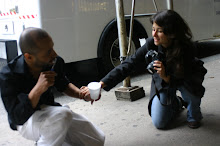YOUTH & REBELLION, IRAN
Fully 60 percent of Iranians are under the age of 30.
Young Iranians have had a great deal of difficulty accessing the benefits of the past decade’s economic growth. In particular, they have been most adversely affected by the persistent unemployment in Iran. The youth have made great strides in education – most urban males and females have at least a high school diploma, and even rural females, long held back by the constraints of their more traditional lifestyles, now typically attain at least some high school education. The length of the gap youths face between leaving school and beginning their first job grows with the amount of education attained, as jobs requiring advanced skills are not readily attainable for young Iranians. Data from 2005 show that while 90% of men have left school by age 23, it is not until age 29 that a corresponding percentage of men have found employment. The situation for young women appears bleaker – while their levels of educational attainment do not differ greatly from those of their male counterparts, the same data set shows that even by their late 20s, only 20% of them are employed. It's been suggested that this is tied to a psychological “bewilderment” effect among women caused by the rules of the regime, many of the women who are unable to find work decide to call themselves “homemakers” and effectively deny their interest in seeking employment – but even these aside, the unemployment rate among young Iranian women remains at approximately 50%.
“Islamic morality police tend to stay away from trendy places like fancy cappuccino bars... One couple says that if the police do raid the café, or even private parties, young people just bribe them to go away. A party, they say, would cost $100.”
Blogging in Iran operates under special circumstances because the government restricts certain views. Blogs in general tend to be unregulated compared to other forms of expression in Iranian society. This characteristic can account for the huge popularity of blogs especially among Iranian youths. As of October 2005, there are estimated to be about 700,000 Iranian blogs (out of an estimated total of 100 million worldwide, of which about 40,000-110,000 are active, mostly written in Persian, the Iranian language). There are also many weblogs written by Iranians in English and other languages. Most of them, though, belong to expatriates who live in North America, Europe, Japan, etc. Iran is the third largest country of bloggers.
http://www.iraniansblogs.com/
Many young Iranians exhibit ambivalent reactions vis-à-vis the West, the product of a dichotomy between widespread admiration for Western culture and frequent disdain for the policies of American and European governments.
Tuesday, March 17, 2009
Monday, March 16, 2009
ABOUT WOMEN
The Islamic Revolution of 1979, which overthrew the Shah, had a huge impact on women's lives: for some it brought restrictions, such as a new dress code; but for others it meant opportunities, like the chance to get an education on a par with men.
In public all females are expected to cover their hair and wear a dress that covers the body. Only the face, toes and hands are allowed to be seen. In recent years though some of the restrictions have become more relaxed. Skirts are getting shorter, women are wearing brighter colors and even make-up.
BBC SPECIAL REPORT
Iran & the Youth
In public all females are expected to cover their hair and wear a dress that covers the body. Only the face, toes and hands are allowed to be seen. In recent years though some of the restrictions have become more relaxed. Skirts are getting shorter, women are wearing brighter colors and even make-up.
BBC SPECIAL REPORT
Iran & the Youth
Subscribe to:
Comments (Atom)
